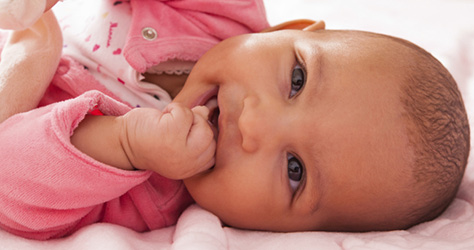Your 6 month old baby development milestones
At 6 months old, they’re half way through their first year and really kicking on (although not quite walking). Read on to find out more about your baby’s sight, touch and starting to wean your baby.
At a glance
- Having been attracted by big movements and bold colours for months, your baby will probably now notice the tiniest details
- The more tummy time your baby has, the stronger their arms and legs will be and the easier they may find moving
- Stranger anxiety is normal from this age. Many babies become clingy around others and may cry if anyone but you comes near

Your baby’s senses at six months old
Touchy feely
Babies of this age are fascinated by touching different textures – feeling running water through their fingers, scrunching up a ball of paper, running their hands along blades of grass. Stimulating their sense of touch is great practice for weaning when they are trying differently textured foods and will also help their curiosity and attention span.
Sight Developments - Details, details
Having been attracted by big movements and bold colours for months, your baby will probably now be noticing the tiniest details – your earrings, the flowers on your shirt, the nose on his teddy bear – starring at them for seconds at a time and even trying to reach out and grasp them with their fist (more delicate finger movements come a bit later).
Your baby’s motor skills developments at six months old
Speech
Talking to baby is a key part of their language development. No matter how silly you might feel, try to keep up a running commentary on everything you’re doing with your baby – it’s a great way to encourage their language. Count the stairs as you climb, show them the leaves on the trees and give everything around you a name. Repetition is the key. It all gets stored away in their brain and it won’t be long before they’ll be able to use it and talk back to you.
To move or not to move?
Some babies choose to commando crawl across the room on their arms, others roll about, and some shuffle on their bottoms. Whatever method your baby chooses to take is normal, so don’t worry. However, the more tummy time your baby has, the stronger their arms and legs will be and the easier they may find moving. Some babies will take off at six months, others won’t move until 10 months and some will skip crawling all together.
Other 6 month old developments
Weaning
From 6 months old you may be thinking about start to wean your baby onto solids. This is an exciting time for your baby as they learn to try new tastes, textures and even colours of food. It’s an important time for both you and your baby and is a great bonding experience as they learn and experiment with their food.
Who’s that stranger?
Stranger anxiety is normal from this age. Many become clingy and anxious around people and may cry if anyone but you comes near. It helps to encourage a bit of socialising – perhaps not cocktail parties yet, but playdates and baby groups get them used to meeting new people.
I know what’s coming next
If you pause in the middle of singing a familiar nursery rhyme your baby will now begin to be able to anticipate what comes next – both from the memory of hearing it before and the expectant tone of your voice and your body language.
How you can help your baby develop in month six
- Babies of this age absolutely love animal noises and they are beginning to understand that different creatures make different sounds. Show him pictures of animals in a book and make all the noises, one by one. He will love it (as will the neighbours)
- Your baby needs plenty of stimulation but don’t think you have to be madly waving toys and making realistic animal noises all day long. They also need quieter periods – a few minutes at a time - when they can play on their own with no prompts. It’s great practice for later if they can learn now to amuse themselves a bit
- Your baby may also like repeating one syllable, such as "ba", "ma", "ga", or other consonant-vowel combinations, over and over. He may even add another syllable or two, making their sounds more complex
- Stacking blocks and cups are going to have a bit of a moment now. Developing hand-to-eye coordination is one of the biggest challenges for your baby, and these are a great way to learn
Game of the month
Touch and feel. Collect some items of different textures – a silky scarf, a square of fine sandpaper, a velvety toy and a hard wooden block – and encourage them to feel each one in turn.
They're all different
A small note on developmental milestones: it’s really true – all babies are different and although we can encourage them, they will do things at their own pace and in their own time and often in a different 'order' to what is sometimes expected. If you are concerned or unsure do seek advice and support from your health visitor - they are trained to listen and help guide you.
Read more about baby development anxiety here and our at-a-glance milestones guide here.
You can also see more about your baby's development with our milestones chart.